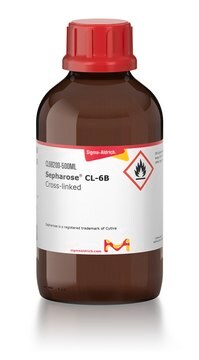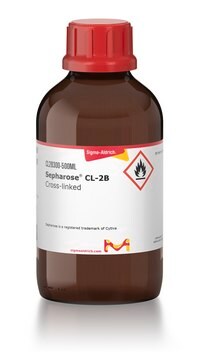About This Item
Recommended Products
biological source
algae (marine)
Quality Level
form
suspension
technique(s)
affinity chromatography: suitable
bead diameter
45-165 μm
pore size
30,000-50,000 Da fractionation range (Dextrans)
60,000-20,000,000 Da fractionation range (Globular proteins)
storage temp.
2-8°C
InChI
1S/C24H38O19/c25-1-5-9(27)11(29)12(30)22(38-5)41-17-8-4-36-20(17)15(33)24(40-8)43-18-10(28)6(2-26)39-23(14(18)32)42-16-7-3-35-19(16)13(31)21(34)37-7/h5-34H,1-4H2/t5-,6-,7+,8+,9+,10+,11+,12-,13+,14-,15+,16-,17-,18+,19+,20+,21-,22+,23+,24+/m1/s1
InChI key
MJQHZNBUODTQTK-WKGBVCLCSA-N
Looking for similar products? Visit Product Comparison Guide
General description
Application
- to conjugate scorpion venom to be used in affinity chromatography
- for clearing of protein extracts prior to immunoprecipitation
- for gel purification and desalting of phospholipid vesicles
- for adsorption of immunoglobulin G (IgG)
Legal Information
replaced by
Signal Word
Warning
Hazard Statements
Precautionary Statements
Hazard Classifications
Flam. Liq. 3
Storage Class Code
3 - Flammable liquids
WGK
WGK 1
Flash Point(F)
100.4 - 109.4 °F - closed cup
Flash Point(C)
38 - 43 °C - closed cup
Regulatory Listings
Regulatory Listings are mainly provided for chemical products. Only limited information can be provided here for non-chemical products. No entry means none of the components are listed. It is the user’s obligation to ensure the safe and legal use of the product.
FSL
Group 4: Flammable liquids
Type 2 petroleums
Hazardous rank III
Water insoluble liquid
ISHL Indicated Name
Substances Subject to be Indicated Names
ISHL Notified Names
Substances Subject to be Notified Names
JAN Code
4B200-VAR:
4B200-100ML:4548173936918
4B200-BULK:
4B200-1L:4548173936925
4B200-1L-C:
4B200-500ML:4548173936932
4B200-PM:
Choose from one of the most recent versions:
Already Own This Product?
Find documentation for the products that you have recently purchased in the Document Library.
Customers Also Viewed
Our team of scientists has experience in all areas of research including Life Science, Material Science, Chemical Synthesis, Chromatography, Analytical and many others.
Contact Technical Service










